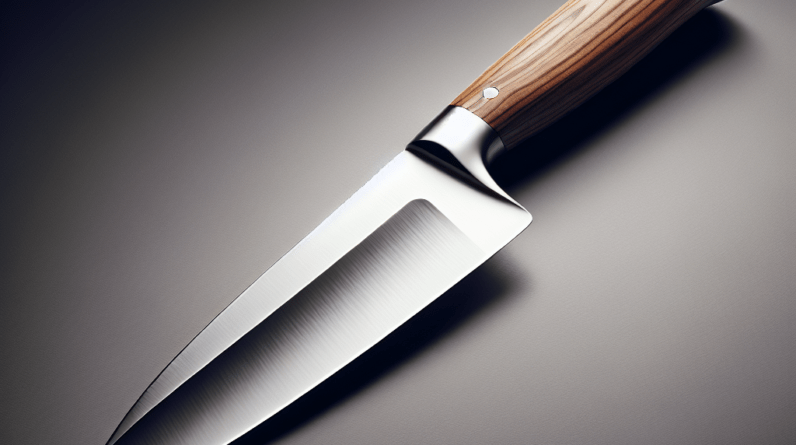In the world of cooking, knives are the ultimate sidekick for any chef. But when it comes to the paring knife, its small size may leave some wondering about its purpose in the kitchen. Fear not, as we unveil the magic of the paring knife – a versatile tool that can tackle a myriad of tasks. From peeling fruits and vegetables with precision to trimming and cutting intricate designs, this little wonder never fails to impress. So, let us embark on a culinary journey to explore the endless possibilities of the humble paring knife. Prepare to be amazed!
Introduction to Paring Knife
Definition of a Paring Knife
A paring knife is a versatile and essential tool in the kitchen. It is a small knife with a sharp, pointed blade that is typically three to four inches long. This knife is designed to handle precise and delicate tasks that require nimble and controlled movements.
Paring Knife Design and Features
Paring knives are typically lightweight and easy to maneuver. They have a thin and narrow blade that tapers to a fine point, allowing for precise cutting and slicing. The blade can be straight or slightly curved, depending on the specific style of the knife. The handle of a paring knife is usually small and comfortable to grip, providing a firm hold during intricate tasks.
Types of Paring Knives
There are several types of paring knives available, each designed for specific tasks. The most common types include:
-
Standard Paring Knife: This is the traditional paring knife with a straight blade and a sharp, pointed tip. It is ideal for tasks like peeling, trimming, and slicing small ingredients.
-
Sheep’s Foot Paring Knife: This paring knife has a slightly rounded blade that resembles a sheep’s foot. It is commonly used for precision tasks like scoring and dicing.
-
Bird’s Beak Paring Knife: Also known as a Tourné knife, this paring knife has a curved blade that resembles the beak of a bird. It is popular for creating decorative presentations and intricate cuts.
Precise and Delicate Tasks
Peeling Fruits and Vegetables
One of the primary uses of a paring knife is peeling fruits and vegetables. Whether it’s a crisp apple, a juicy peach, or a humble potato, a paring knife allows us to effortlessly remove the skin without wasting any of the flesh. The sharp blade and compact size make it easy to navigate the contours of the produce, resulting in smooth and even peels.
Trimming and Removing Blemishes
When it comes to preparing ingredients, a paring knife is perfect for trimming and removing blemishes. Whether we need to remove the eyes from a potato or trim the ends of a green bean, a paring knife provides the precision required to achieve clean and neat cuts. It allows us to work with precision, ensuring that we remove only what is necessary without wasting any part of the ingredient.
Scoring and Zesting Citrus Fruits
Scoring and zesting citrus fruits are other tasks where a paring knife shines. Scoring involves making shallow cuts into the rind of the fruit to make it easier to peel or segment. A paring knife’s sharp point and fine blade allow us to score the rind without penetrating too deeply into the flesh. Additionally, zesting, which involves removing the colorful and fragrant outer layer of the citrus peel, can be easily done with the fine blade of a paring knife.
Creating Decorative Presentations
Tourne Cut and Turning Vegetables
If we want to elevate our culinary creations and add a touch of finesse, a paring knife can help us achieve that. The tourne cut is a decorative vegetable cut where a vegetable is skillfully trimmed and carved into an oblong shape with seven equal sides. This technique is often used to create visually appealing garnishes for dishes. With its pointed and nimble blade, a paring knife is the perfect tool to execute the tourne cut and turn vegetables into stunning works of art.
Garnishing and Fine Decorations
Paring knives are also instrumental in creating intricate garnishes and fine decorations for dishes. From delicate vegetable carvings to decorative fruit peels, a paring knife allows us to add the finishing touch to our culinary masterpieces. Whether it’s creating a beautiful rose from a tomato or finely slicing radishes into intricate patterns, a paring knife’s precision and control make it the go-to tool for intricate detailing.
Precision Work on Small Ingredients
Removing Seeds and Cores
Paring knives excel at handling small and delicate ingredients. Their sharp and precise blades make them perfect for removing seeds and cores from fruits and vegetables. With a simple twist and slice motion, we can easily remove the center core of an apple or scoop out the seeds from a bell pepper. Paring knives offer the control and accuracy needed to perform these tasks without damaging the surrounding flesh.
Hulling Strawberries
Strawberries are a beloved fruit in many dishes and desserts, and a paring knife comes to the rescue when it comes to hulling them. Hulling refers to the process of removing the tough and leafy green cap from the top of the strawberry. With its nimble blade and sharp point, a paring knife allows us to precisely cut around the cap and remove it with ease, minimizing wastage and saving valuable fruit.
Precision Slicing and Dicing
When it comes to slicing small ingredients with precision, a paring knife is our trusted companion. From thinly slicing garlic cloves to dicing shallots or mincing herbs, a paring knife offers the control and maneuverability needed to accomplish these tasks flawlessly. Its small size and sharpness ensure that we can cut through ingredients with precision and ease, resulting in consistent and evenly sized pieces.
Miscellaneous Uses
Opening Packages and Boxes
Aside from its primary uses in the kitchen, a paring knife also comes in handy for various non-culinary tasks. When we find ourselves struggling to open stubborn packages or boxes, a paring knife can be our secret weapon. Its sharp blade effortlessly slices through tape and cardboard, making the daunting task of opening packages a breeze.
Removing Stickers and Price Tags
Another practical use for a paring knife is removing stickers and price tags. We’ve all experienced the frustration of trying to peel off a sticker or tag, only to be left with sticky residue or torn paper. A paring knife’s sharp point and fine blade allow us to gently and precisely lift these stubborn adhesives, ensuring a clean and residue-free surface.
Caring for Your Paring Knife
Proper Cleaning and Maintenance
To ensure the longevity and performance of our paring knife, proper cleaning and maintenance are essential. After each use, we should wash the knife by hand with warm soapy water, taking care to remove any food particles or residue. It is important to avoid soaking the knife or using harsh abrasives, as this can damage the blade. Once clean, we should dry the knife thoroughly and store it in a safe place, away from other utensils to prevent accidental damage.
Sharpening and Honing
Over time, even the best quality paring knife will require sharpening. To maintain its sharpness, we can use a honing steel to realign the blade’s edge between sharpening sessions. Honing helps keep the knife at its optimal performance, ensuring clean and effortless cuts. When the knife starts to feel dull or lose its cutting ability, it is time to sharpen it using a sharpening stone or a professional knife sharpener. Regularly sharpening the blade will keep it in top condition and ready for any kitchen task.
Choosing the Right Paring Knife
Blade Material
When selecting a paring knife, the type of blade material is an important consideration. Stainless steel blades are popular choices as they are resistant to rust and corrosion. They are also relatively easy to sharpen and maintain. High-carbon stainless steel blades offer added strength and durability, making them suitable for heavy-duty use. Ceramic blades are another option, known for their exceptional sharpness and resistance to staining. However, they can be more fragile and prone to chipping if not handled carefully.
Handle Material
The handle material plays a crucial role in the comfort and stability of a paring knife. Common handle materials include wood, stainless steel, and various types of synthetic materials like plastic or rubber. The choice of handle material often comes down to personal preference. Some prefer the warmth and natural feel of a wooden handle, while others prefer the durability and hygiene of synthetic materials.
Size and Weight
Paring knives come in various sizes and weights, and the right choice depends on individual preferences and intended use. A shorter and lighter paring knife offers greater agility and precision for delicate tasks, while a longer and heavier knife provides more leverage for tougher ingredients. It is important to find a balance that feels comfortable and natural in our hands, allowing for optimal control and maneuverability.
Paring Knife Alternatives
Utility Knife
While a paring knife is incredibly versatile, there may be times when we need a longer and more substantial blade. In such cases, a utility knife can be a suitable alternative. Utility knives typically have a blade length of around six inches, making them suitable for a wider range of cutting tasks, including slicing larger fruits and vegetables or even meats.
Bird’s Beak Knife
Although our beloved paring knife excels at intricate cuts and decorative presentations, sometimes we may require a knife with an even more pronounced curved blade. This is where a bird’s beak knife, also known as a tourné knife, comes into play. With its curved blade resembling the beak of a bird, it allows for even more precise peeling, shaping, and intricate detailing.
Peeling Knife
For those who frequently undertake larger peeling tasks, such as peeling a bushel of apples or a bag of potatoes, a peeling knife might be a better choice. Peeling knives typically feature a longer, straight blade that allows for efficient and quick peeling over larger surfaces. These knives are designed for speed and are perfect for tasks that require a bit more efficiency.
Conclusion
In conclusion, a paring knife is an indispensable tool in the kitchen with a wide range of uses. From peeling fruits and vegetables to creating decorative presentations, this versatile knife allows us to execute precise and delicate tasks with ease. Whether we’re removing the seeds from a bell pepper, garnishing a dish, or opening a package, a paring knife proves to be a reliable and versatile companion. By properly caring for and choosing the right paring knife, we can ensure that this essential tool will always serve us well in our culinary endeavors.









